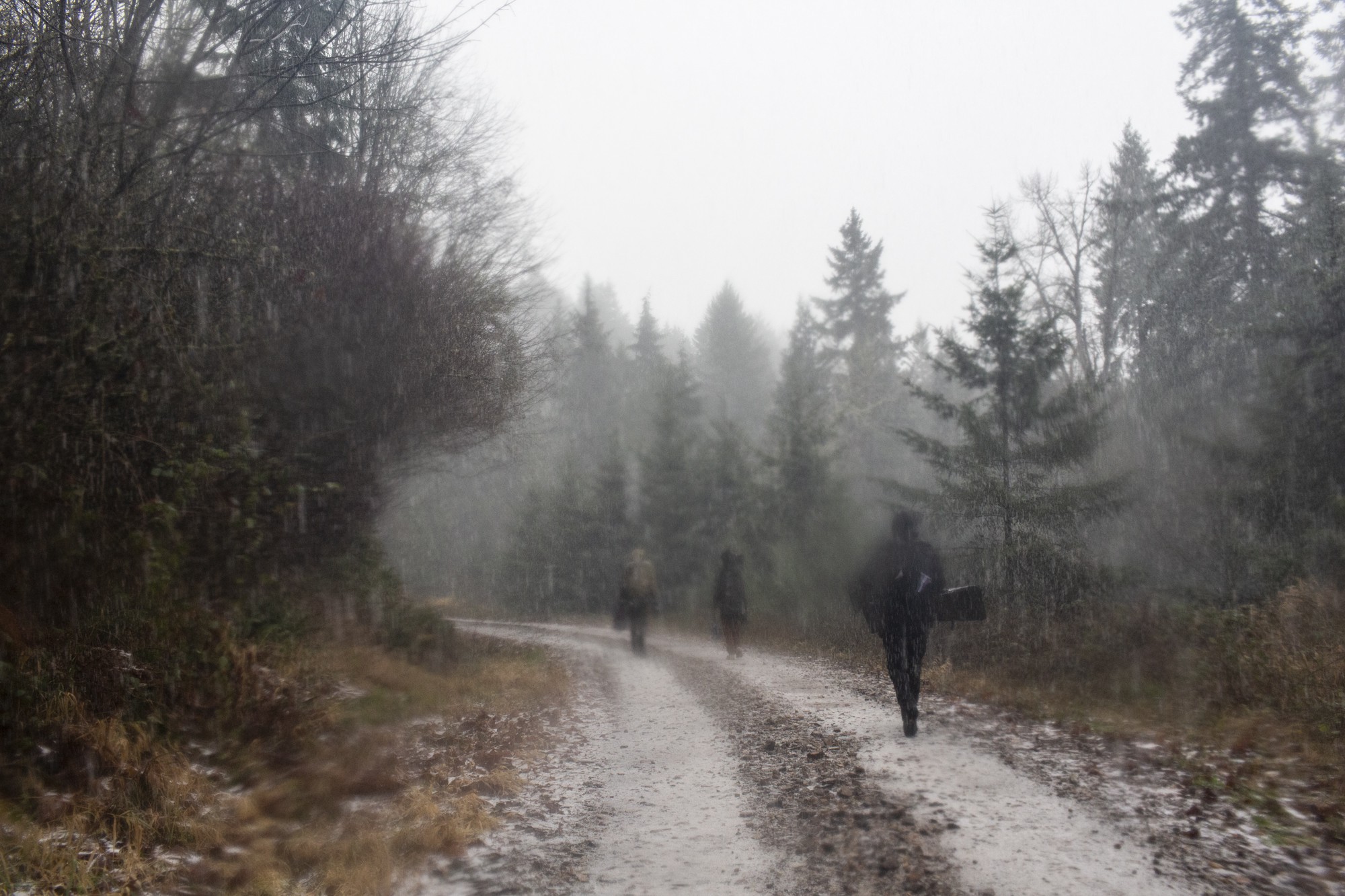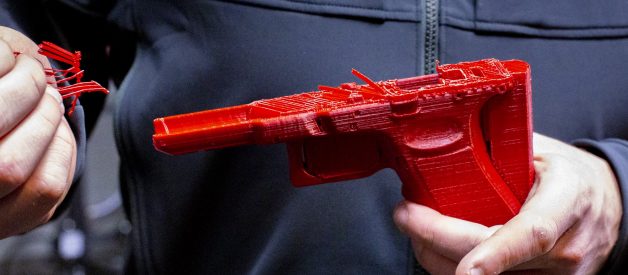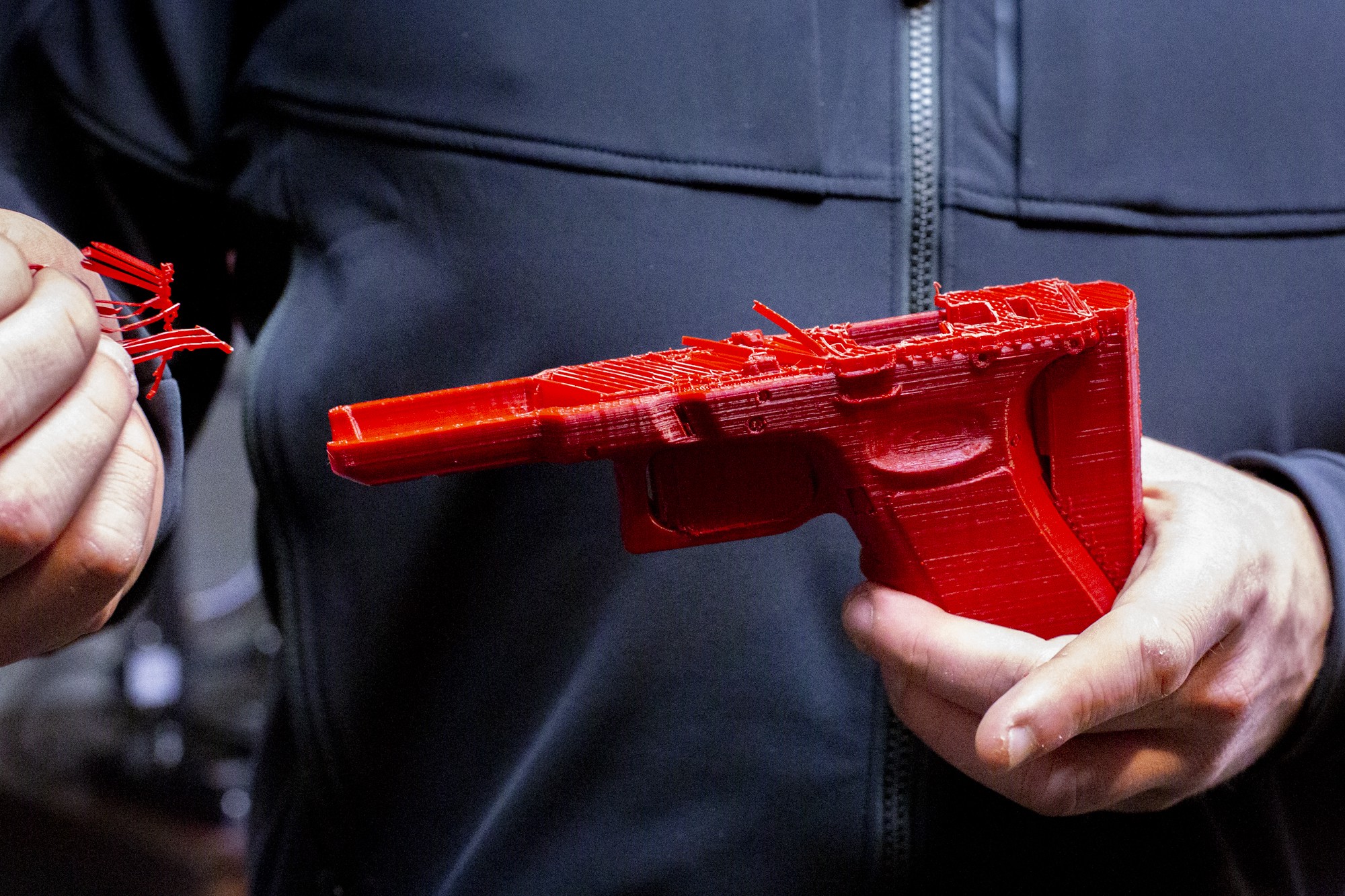 An unfinished 3D-printed Glock pistol frame. Photos: Jenny Riffle
An unfinished 3D-printed Glock pistol frame. Photos: Jenny Riffle
All you need is a blueprint, a polymer, a printer, and a knowledge of government regulations?so you know how to bend them
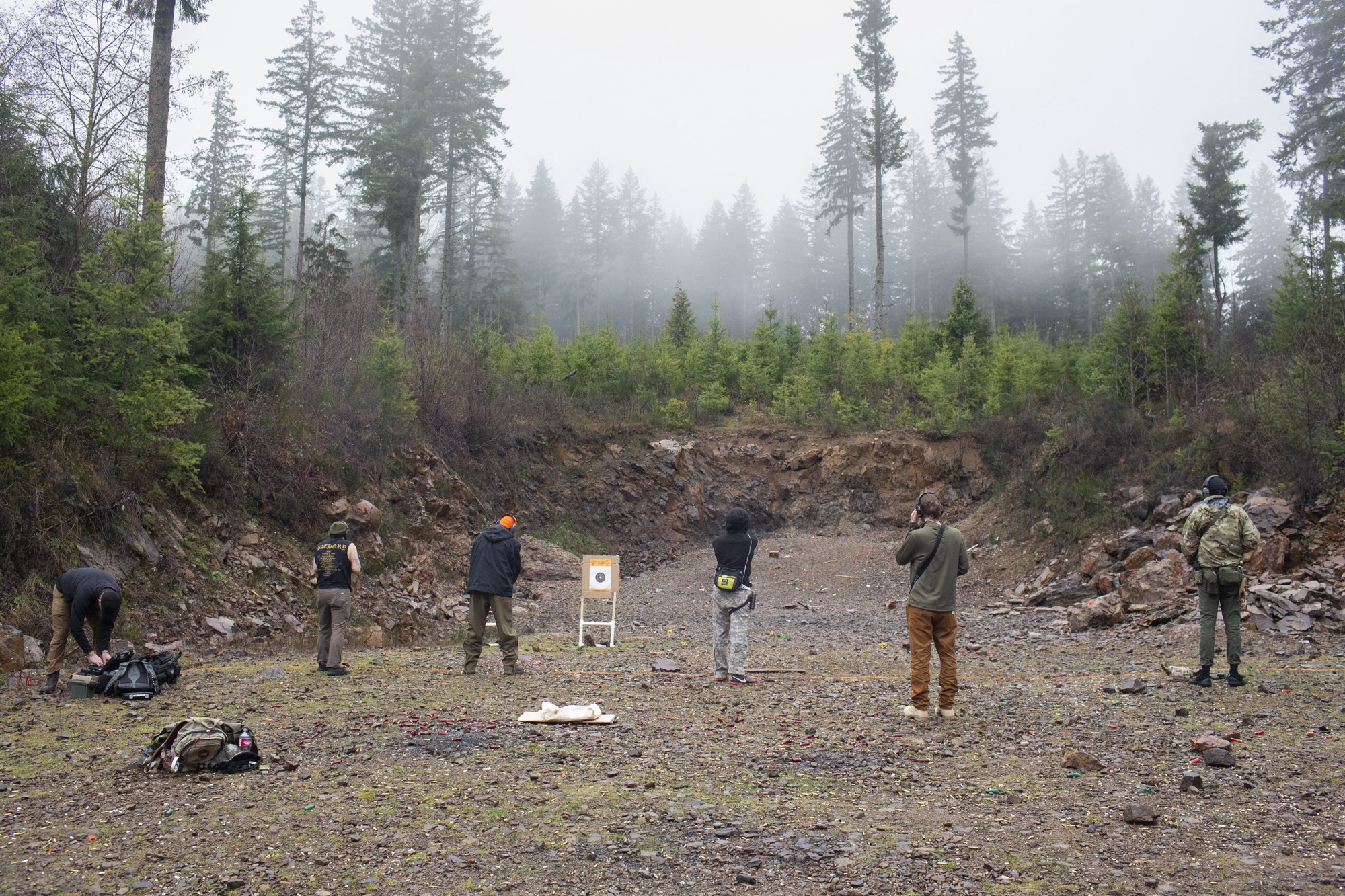 Members of the John Brown Gun Club at target practice outside of Monroe, WA.
Members of the John Brown Gun Club at target practice outside of Monroe, WA.
I grew up around guns. I was born and raised in a poor and working-class community in the middle of a South Jersey nature preserve, and all the men in my family are hunters. Their homes have always been littered with assorted shotguns, hunting rifles, and whatever other pieces happen to strike their fancy. My dad is partial to Civil War-era replica rifles, which he stores in the same big metal safe as his pistols and his AR-15.
If my teenage bedroom was a crossover between a Sephora and a Hot Topic, the basement was always my dad?s miniature version of a Cabela?s. It?s where he keeps most of his hunting gear, his trophies, his bows and arrows, his knives, his NRA memorabilia, and his shotguns, and it?s where he?ll spend hours reloading his ammo or grinding deer meat for sausage in his makeshift butcher shop. Where I come from, guns are tools ? dangerous ones that require proper training, safety measures, and respect for their lethal potential ? but tools just the same; their primary use was always for feeding the family.
Though I wasn?t all that interested in guns when I was younger, my stance shifted as I got older and my politics became more radical. After the deadly 2017 Unite the Right rally in Charlottesville, Virginia ? where I narrowly avoided being hit by the speeding Dodge Charger that killed Heather Heyer ? I became more invested in the idea of armed community self-defense as I first saw it defined by the Black Panthers and then expanded upon by anarchist author scott crow. I have been shooting regularly at an indoor range in South Philadelphia for the past year and am a member of the Socialist Rifle Association.
The range I frequented pre-Covid-19 is a fairly welcoming place without much of the overtly pro-cop, right-wing garbage that frequently decorates these kinds of establishments. The range itself is louder than hell, and some of the crustier, older staffers can be grumpy. But as far as gun ranges go, it?s pretty chill, and the clientele is quite diverse. (On one memorable visit, Philly rapper Meek Mill and a handful of his friends came by and rented the lane next to mine; he seemed to be having a great time, though I won?t comment on his accuracy.)
The one thing all of these homemade firearms have in common is that they are untraceable, untrackable, and completely legal under U.S. federal law.
I?ve spent enough time in the heavy metal and punk worlds to maintain a healthy appreciation for the do-it-yourself ethos, but I had no idea it was even possible to take a DIY approach to guns until a passing comment from my friend Nick ? who asked me to omit his last name from this piece for privacy?s sake ? ignited my interest.
I was out in Seattle reporting on the Puget Sound John Brown Gun Club, an armed leftist community defense organization, and Nick was acting as the group?s informal press liaison. A tall web designer in his mid-thirties with a sonorous voice and studious demeanor, Nick also happens to be a font of firearms knowledge and has long been interested in 3D printing technology. When he told me about the experiments in gun-building he?d been doing on his kitchen table, my initial reaction was that it sounded like something out of Blade Runner.
It blew my mind to hear that he had been using a 3D printer assembled out of $175 worth of Chinese parts he bought online (instead of spending hundreds or potentially thousands on a store-bought version) to churn out Glock frames and various other gun components. These gun parts are often sold in kits and take much less effort to acquire online but come at a much steeper price and without the wealth of potential modifications that 3D printing affords. But Nick, as tech-savvy as he is, wasn?t running a one-person 3D-gunsmithing operation on his own. As I soon discovered, he was part of an entire underground community of rogue gunsmiths.
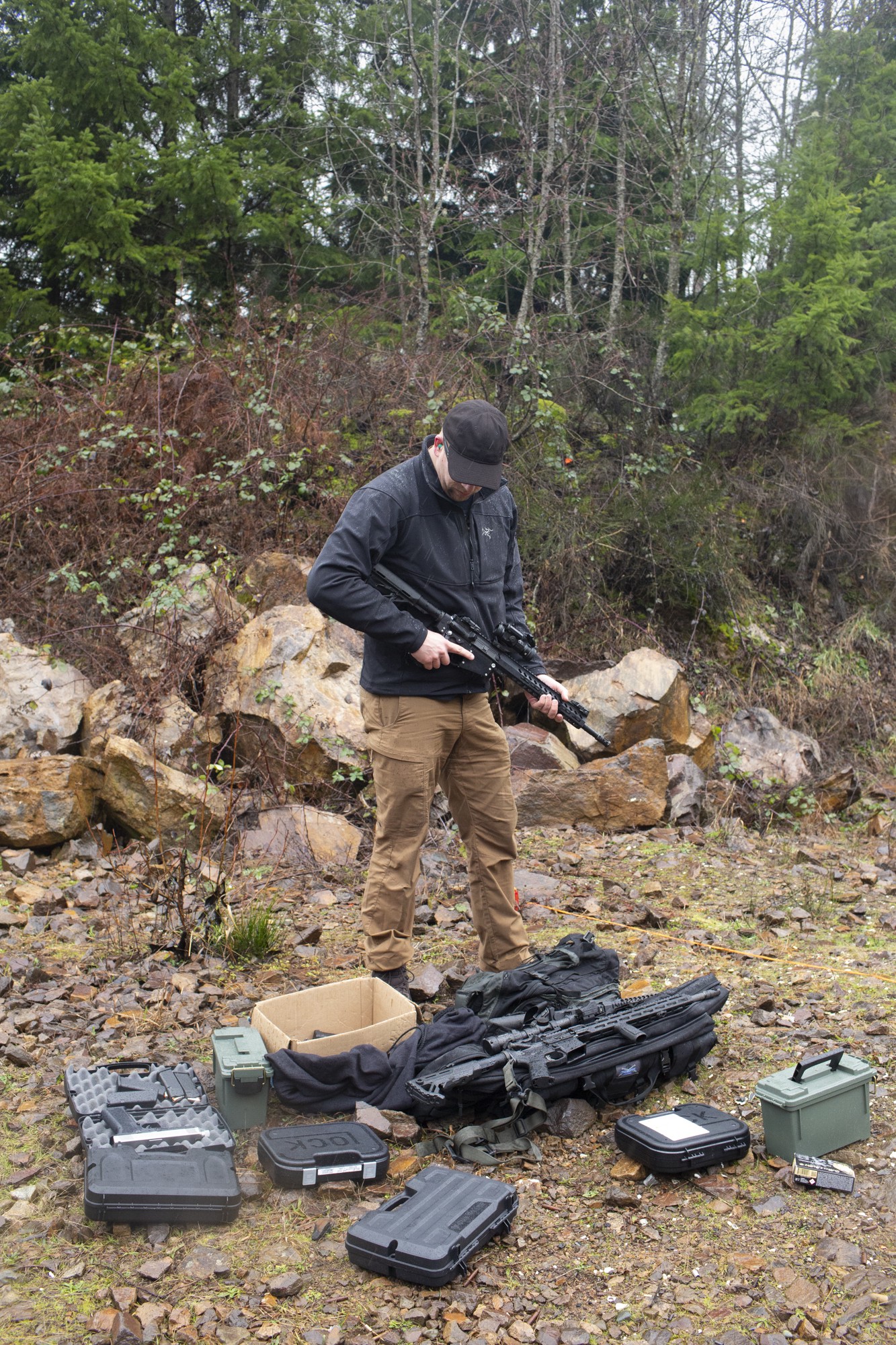 At the shooting range with an AR-15 and a 3D printed lower receiver.
At the shooting range with an AR-15 and a 3D printed lower receiver.
On a chilly day in early January, I met up with Nick and his friends Koff, Levi, and Kadie in the woods outside Monroe, Washington, a small town about 40 minutes outside Seattle. Washington state has over 42 million acres of public land on which recreational target shooting is legal, so we each grabbed some gear and tramped half a mile into the verdant forest. Once we got to the makeshift range ? a gravel pit that had been marked up with a firing line and a handful of targets ? Nick pulled out his range of homemade weapons, and my jaw dropped. He?d brought along a variety of different DIY options, including an AR-15 with a 3D-printed lower receiver held together by store-bought bolts. He also brought a PM522 Washbear revolver that was entirely 3D-printed save for its firing pin (a small glued-in nail), some metal scrap in the handle, and some internal elastic to act as springs. Nick cracked a smile as he pointed out the material ? a condom. The Washbear still needed testing, but I watched in awe as Nick successfully fired the AR-15 for the first time, drawing whoops from our small group.
Koff let me try out his Glock 26 clone ? a DIY 9mm with a fetching Tiffany Blue Polymer 80 subcompact frame. It felt similar to the factory-issue Glock 19 that I usually shoot with at the Philly gun range but was far more pleasant to handle overall thanks to added stippling on the grip and a modified undercut on the trigger guard. The stippling made it so much more comfortable to grasp. These kinds of small, user-friendly modifications illustrate one big reason why some firearms enthusiasts are so drawn to DIY guns: The ability to play with a gun?s design and improve their own user experience without having to wait on major manufacturers to catch up.
Afterward, we headed to Levi?s house to watch Nick break out his 3D printer and show off. The day?s project: a magazine sleeve, an add-on part that?s mostly used for cosmetic purposes or to improve a grip. Nick walked me through each step of the process and explained the relative merits of different kinds of polymer filament; one interesting aspect of PVA polymer is its water solubility, a factor that got Nick thinking about the implications from the perspective of law enforcement.
?I wonder if that would be strong enough you could fire off a round, throw the gun in the lake, and then it disappears, except for the firing pin and the spring,? he mused. ?If an investigator isn?t thinking about that, they send scuba divers into the water, and there?s nothing there.?
This train of thought is a little chilling when one considers the U.S.?s ongoing gun violence epidemic. A single-use, disappearing murder weapon sounds like the stuff of a far-fetched CSI episode, but it?s becoming more of a reality. But Nick sees little reason to worry about it ? yet. ?I can?t imagine the use of it outside of proof of concept,? he says. ?But you want to know how to do these things, especially if you?re thinking about being an investigator. If you don?t think it?s possible, somebody is going to think of it first.?
This got to a bigger question lying at the heart of our conversation: Why would someone want to 3D-print a gun? Is there any legitimate reason to create an untraceable firearm outside of a desire to commit some kind of crime?
?3D-printing a gun is really difficult to do ? as opposed to milling a gun, as opposed to stealing a gun, or just buying the gun and committing the crime with it illegally,? Nick explained.
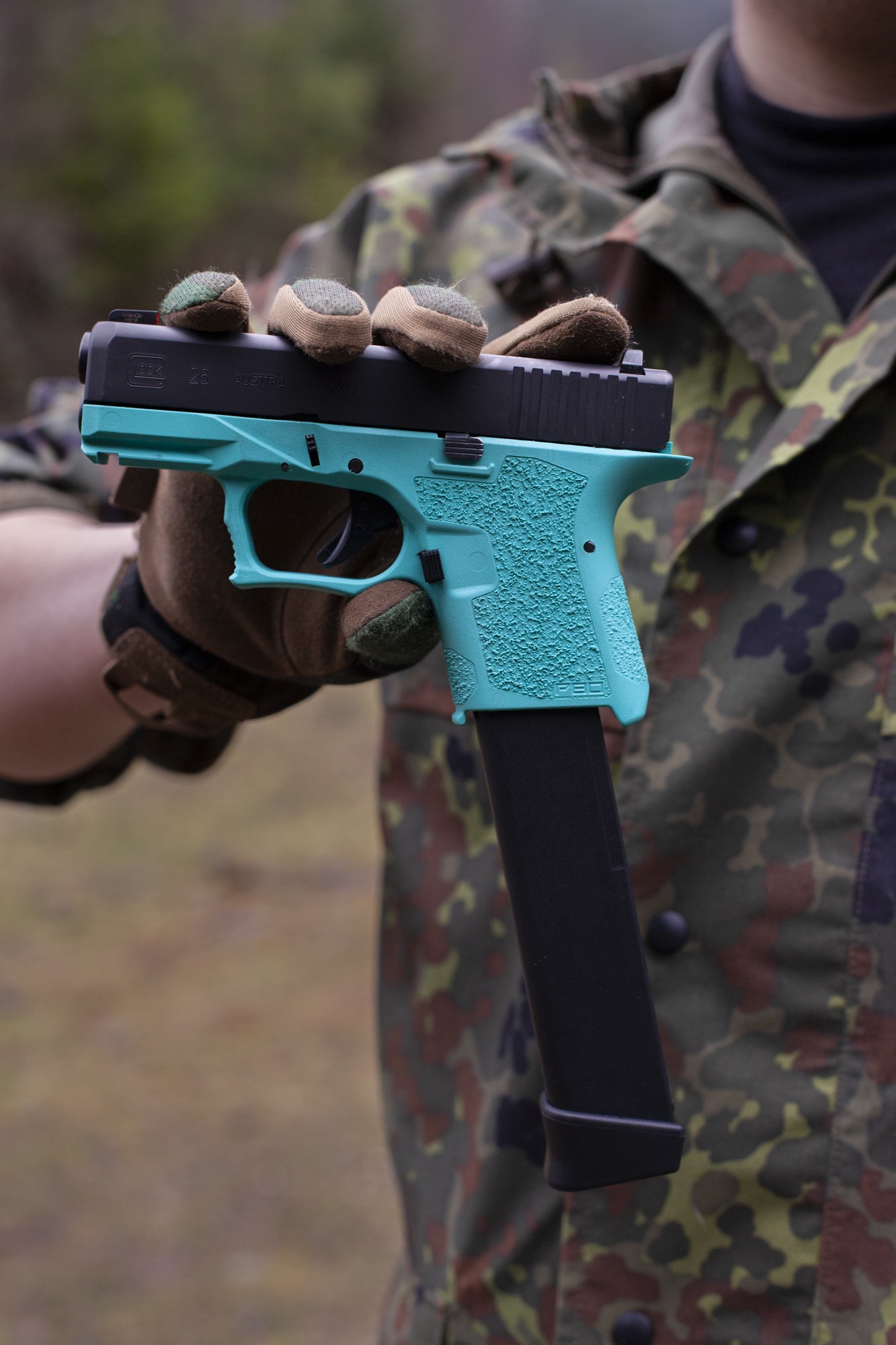
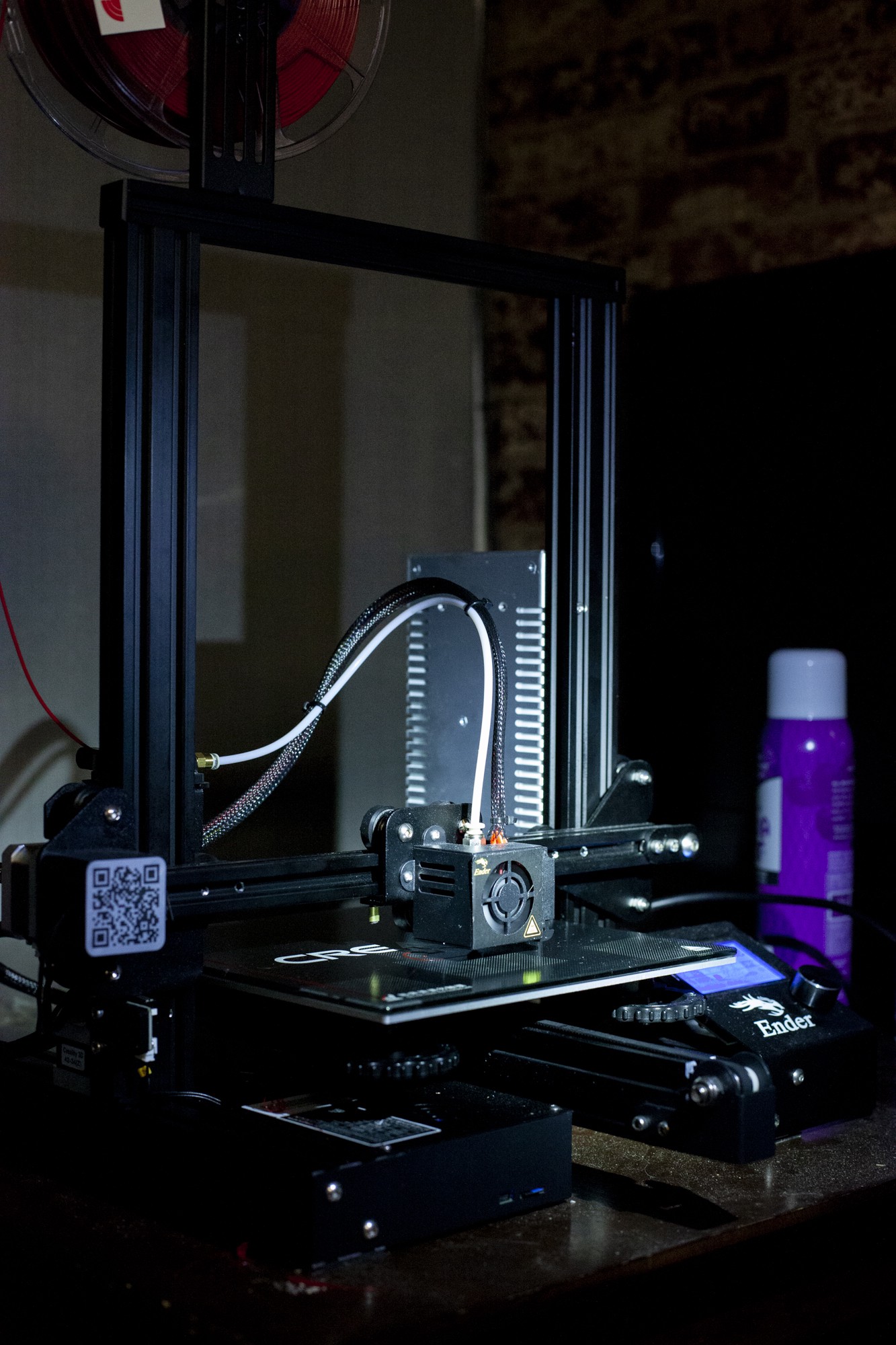 Left: a DIY 9mm Glock 26 clone with a Tiffany blue Polymer 80 frame. Right: A 3D printer assembled out of $175 worth of Chinese parts.
Left: a DIY 9mm Glock 26 clone with a Tiffany blue Polymer 80 frame. Right: A 3D printer assembled out of $175 worth of Chinese parts.
But the heart of the issue has to do with a fear of government overreach. ?There?s a law in Washington state where if somebody comes in and steals your gun then uses it in a crime ? if the state decides that you didn?t safely store your firearm, then you can be liable for the crime. It?s harder to prove if that gun isn?t registered to you and if there?s no serial number on it.?
When Washington state launched a bump stock buyback scheme in 2019, the program proved so popular that it ran out of money. It also spurred a federal lawsuit on the grounds that it had exposed the buyback?s 324 participants to the risk of having their names and addresses publicly disseminated via public-disclosure requests.
Nick watched this saga unfold with great trepidation and cites its mishandling as a reason that ghost guns appeal to him personally. ?I think police do go after activists a little bit more,? he explained. ?I don?t want to put myself at risk by telling the government how many guns I own. Or telling anybody how many guns I own.?
Nick is a member of ?a couple of local lefty gun groups? alongside his pals, and he also teaches self-defense in his free time. ?I got into firearms as a progression from thinking about different ways of self-defense,? he told me. ?I?ve been to a lot of events and seen police brutality towards activists; I?ve also had experiences of having people yell slurs at me from their trucks when I walk down with someone they thought was a queer partner. Defense is often on my mind.?
As we watched the printer hum along, slowly, a small red figure grew. After almost an hour, a nearly-finished magazine sleeve sat triumphantly on the printer plate; Nick told me it takes a full 24 hours to print an entire Glock frame. In the meantime, Levi showed Koff how to mill out an 80% lower. Levi could share his tools and knowledge, but to stay inside the law, Koff needed to perform the actual labor himself. (?Welcome to the land of firearm regulations,? Levi said.) Kadie fussed over a faulty rear slide on their almost-completed Glock 19 as Levi?s new puppy, Emma, gamboled at our feet and his wife curled up on the sofa, catching up on the news.
It all felt very wholesome and nerdy, and in essence, it was ? a gathering of hobbyists working on their new toys. ?We?re not out here with like, ammunition bandoliers and fucking eye patches,? one of the participants said. ?We?re just normal people.?
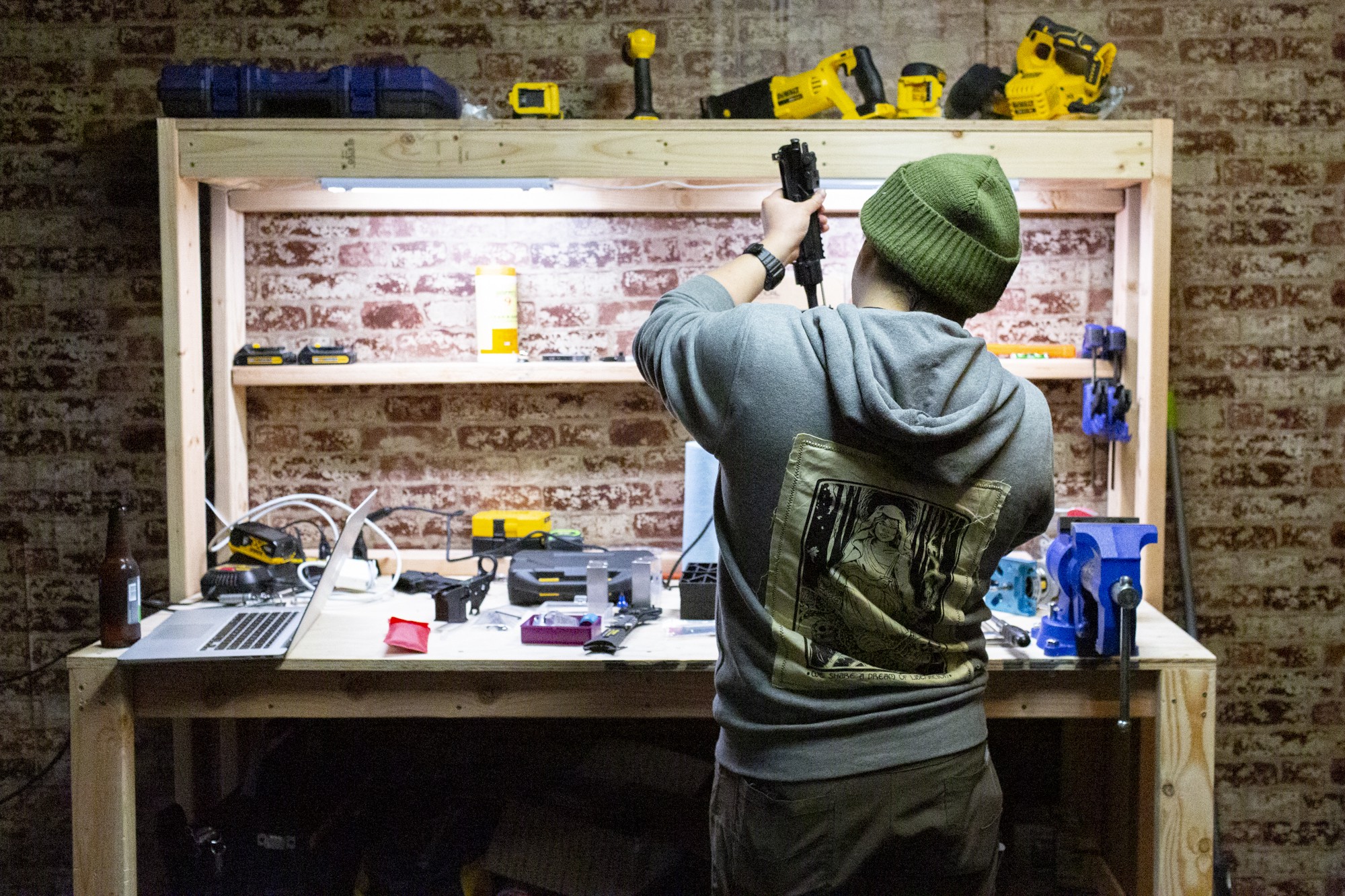 A workbench at Levi?s house with various parts scattered around. It?s legal to 3D-print a plastic firearm as long as there is a detectable metal element within its body.
A workbench at Levi?s house with various parts scattered around. It?s legal to 3D-print a plastic firearm as long as there is a detectable metal element within its body.
The only aspect about this cozy scene that might give an outsider pause is that the government doesn?t know a damn thing about any of this. There are simply too many potential loopholes, and there is still a massive knowledge gap about the process and the final products ? to say nothing of the current administration?s allergy to gun control in any form. Law enforcement officers regularly misidentify homemade weapons; in multiple instances, police have reported the use of a scary ?3D-printed gun? when the weapon is a perfectly legal Polymer 80.
However, this hasn?t stopped state and federal legislators from trying to regulate 3D-printed guns. In 2013, the House of Representatives voted to extend the Undetectable Firearms Act of 1988 ? a ban on any firearm that is undetectable via walk-through metal detectors ? for an additional 10 years. Despite the efforts of lawmakers like Sen. Chuck Schumer to add new restrictions, it is still entirely legal to 3D-print a plastic firearm as long as there is a detectable metal element somewhere within its body.
The vagueness of the law?s language allows for DIY gunsmiths to get creative in their rule-following efforts. For example, Nick inserts clusters of roofing nails inside the grip of his 3D-printed Washbear. And for those less interested in matters of legality, it?s even easier to flout the weak regulations in existence. Last year, U.S. Sen. Bob Menendez from New Jersey found this out for himself when he decided to take on one of the 3D-printed gun community?s most outspoken and prolific figures, a man known only as Ivan the Troll.
On March 7, 2019, Menendez sent a letter to Twitter CEO Jack Dorsey asking him to ban the Twitter account of user IvanTheTroll12. The account was associated with one of the core designers at Deterrence Dispensed, the online collective that designs and shares 3D-printable firearm CAD files. Several weeks before, IvanTheTroll12 tweeted out a link to download the full CAD plans for an AR-15 rifle ? modified from a faulty design Defense Distributed had released into the public domain ? and promoted the release on his Twitter account. Then, IvanTheTroll12 and his co-designers at Deterrence Dispensed got to work on another project. They were caught off-guard when they heard about the Menendez letter.
?At first I thought it was just hilarious,? Ivan tells me when I called him at his home, whose location he declined to disclose. (?Ivan? may or may not be a pseudonym, but it is how we will refer to him here.) The ?plans? he?d distributed were a reference assembly, he explains; it would take ?a multibillion-dollar machine shop? for someone to build a functional AR-15 using the files. ?But then I got word my identity was desired by anti-gun groups. It wasn?t Menendez who came up with this ban organically on his own; anti-gun groups found me and brought it to Menendez. They were like, you need to stop this guy, he?s crazy.?
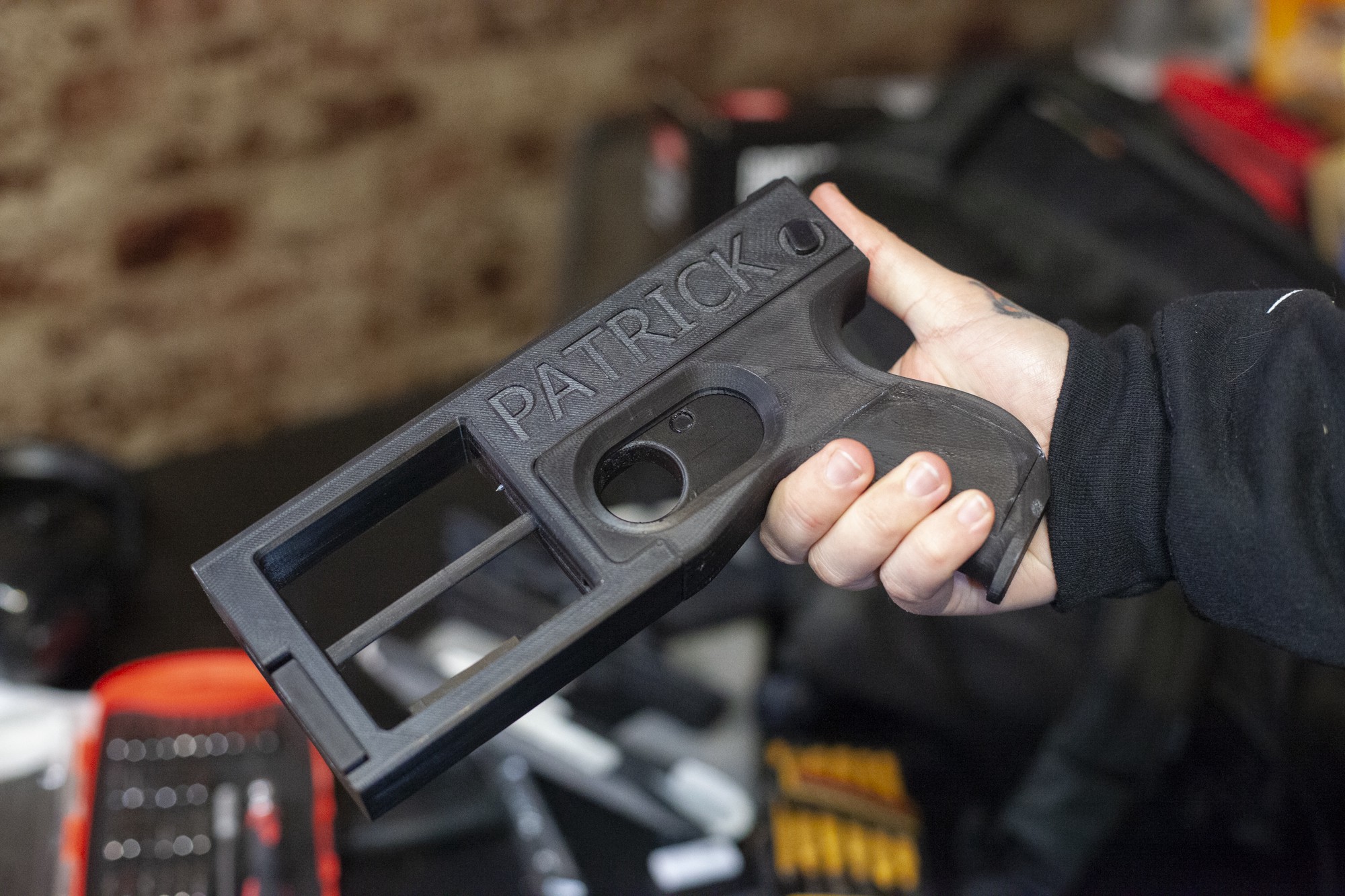 A 3D printed Washbear pm522 revolver, designed by mechanical engineering student James Patrick in 2015. Unlike the Liberator, it can fire multiple shots.
A 3D printed Washbear pm522 revolver, designed by mechanical engineering student James Patrick in 2015. Unlike the Liberator, it can fire multiple shots.
Ivan was eventually banned from Twitter, YouTube, and Reddit. He started another Twitter account, which was also eventually shut down; he?s now on yet another account. ?It wasn?t long after my second account was banned that Twitter finally implemented the rule that says that you can?t share gun CAD on Twitter,? Ivan says with a sigh. In June 2019, Menendez introduced the 3D Printed Gun Safety Act, which has the backing of a number of high-profile politicians, including Sens. Cory Booker, Sherrod Brown, Kamala Harris, Dianne Feinstein, Tammy Duckworth, Amy Klobuchar, and Bernie Sanders.
Ivan saw this as a turning point. Before, printing 3D gun parts was a hobby, an experiment. Now, it was personal. Ivan has more than earned his ?troll? nom de guerre with a homemade piece de resistance: A 3D-printable ?high capacity? Glock magazine he dubbed the ?Menendez mag.? ?His family?s name will forever be cursed,? he told me with audible glee. ?For as long as the internet exists, his name will be attached to a magazine that nobody can ban. I?ll make sure this magazine is around after he is forgotten simply because he pissed me off.?
Despite his insistence that he is a fiercely private individual, Ivan was downright chatty on the phone and happy to talk about the ins and outs of the numerous designs for which he and others in his group are responsible, including Ivan?s infamous Plastikov, the world?s first 3D-printable AKM receiver (the AKM is a modernized variant of the AK-47). A member of his collective, JStark1809, designed the similarly-hyped FGC-9 (Fuck Gun Control 9) handgun, an almost entirely 3D-printed 9mm semiautomatic pistol similar to but more powerful than the Liberator.
Ivan?s own politics are a hodgepodge of various leftist ideologies: libertarianism, anarchism, and crypto-anarchism, plus a more traditionally conservative focus on Constitutional rights. His kitchen-sink approach differs from that of Nick and his friend, who operate from a straightforwardly leftist, anti-fascist, anti-authoritarian POV. Ivan?s not a big fan of the federal government and its regulatory bodies or of anyone else who he sees as trying to tell him what to do. His grandfather, whose own father escaped a famine-gripped Ukraine, instilled in him a need for self-defense and a distrust of government power. Ivan grew up around guns, too, and started acquiring his own in high school, where he also discovered his aptitude for computer-aided design.
?My personal view is that people won?t stop trying to restrict my personal liberties, and my best way of fighting it is by trying to enshrine the means to those personal liberties in the public domain of information; you can?t really ban a book that?s been published, can?t really ban a set of CAD plans for a gun once they are online,? he says.
Law enforcement officers regularly misidentify homemade weapons; police have reported the use of a scary ?3D-printed gun? when the weapon is a perfectly legal Polymer 80.
As my interview with Ivan progresses, I find myself thinking back to something Nick told me in Seattle. ?There?s certainly a sector of the gun building population that realizes they are breaking a rule they?re able to get around. It just seems clever and cool to be able to say, ?I created a gun; you can try to ban it,?? Nick said. ?People will ask, what about ammunition? You can make ammunition at home. What about barrels? And then somebody comes out with a way to make a barrel for 3D printing and a battery in saltwater. If you are an extremely online person, you get to laugh at the people who think they?re able to take those away from you.?
Ivan is sincere in his desire to make the knowledge he?s acquired accessible to anyone who may have use for it, whether or not he agrees with what that use may be. And for both Ivan and Nick, the importance of being able to defend oneself and exercise one?s rights outweighs the potential risks, no matter how serious.
As far as Ivan is concerned, even if a far-right extremist like the Halle gunman were to use one of his designs to commit a mass shooting, it?s not his problem. He isn?t thrilled with the idea (?That should be a given?), but his commitment to his own personal vision of unfettered, equal access to guns for all is unwavering. Ivan and his cohorts have been so preoccupied with whether or not they could, they haven?t necessarily stopped to think if they should, and we won?t find out what impact those decisions have had until the answer flashes onto our TV news screens.
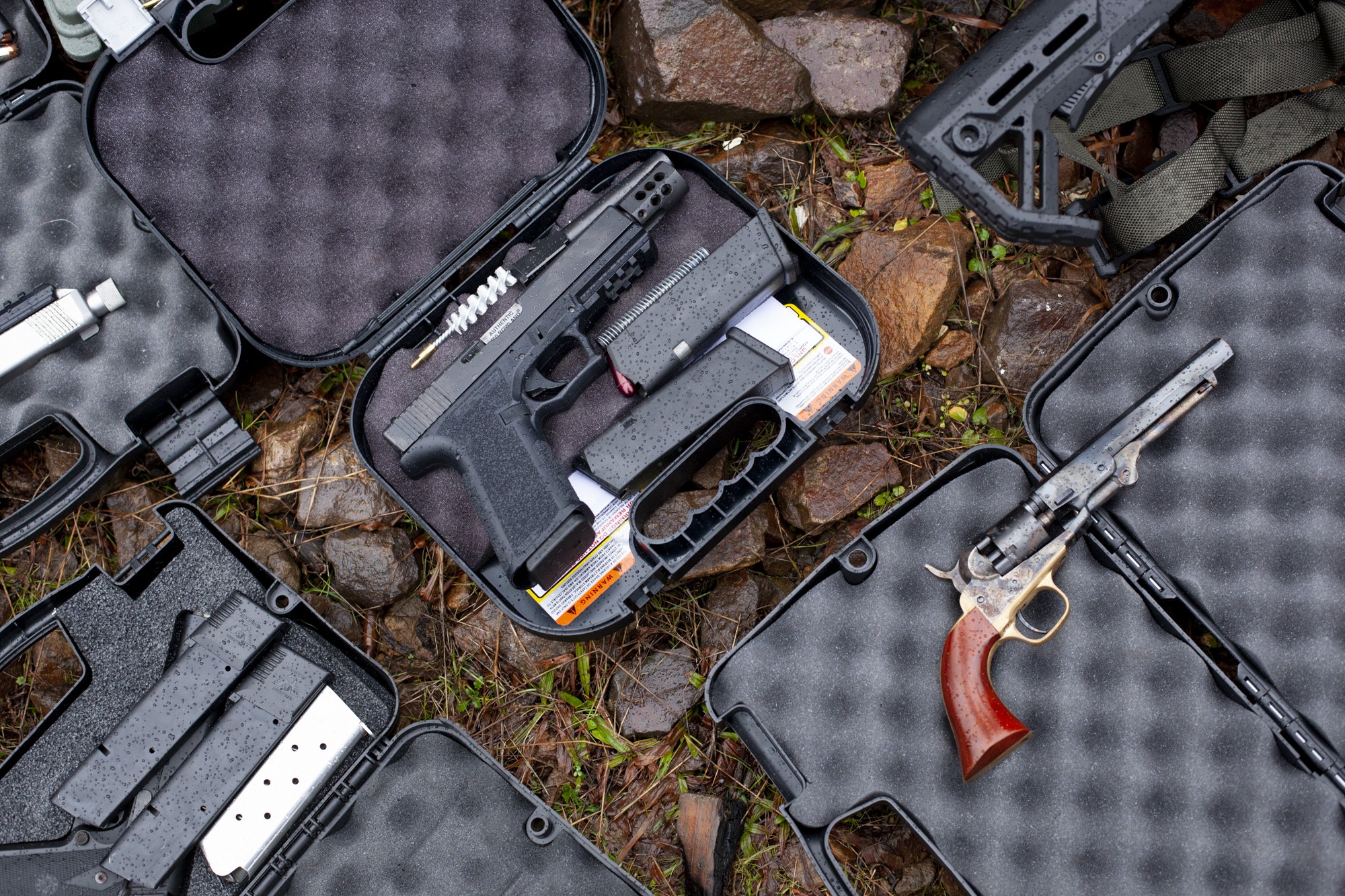
With the ongoing Covid-19 pandemic disrupting supply chains, spooking consumers into stockpiling resources, and sowing general panic, some people ? many of them first-time gun owners ? have been making a mad dash to the gun store to stock up on guns and ammunition. Gun sales are now up 90% from March, and ammo is in increasingly short supply. Ivan and others in his 3D-printing orbit have been watching this development with great interest. ?In uncertain times, firearms grant a certainty the government can?t ever do, especially with a bumbled federal handling of a crisis,? he says.
For his part, Nick has been staying the course and has attended a few of the Seattle protests that sprang up following George Floyd?s murder. His commitment to community self-defense has only become more resolute in the wake of the continuing wave of police brutality and white supremacist violence.
Nick?s overall approach makes sense to me, but Ivan was more of a puzzle, even after we had numerous text conversations and spoke on the phone for nearly two hours. Ivan got involved in 3D printing much the same way Nick did; for both, it was a fun, nerdy hobby that grew into something bigger, but from there the paths of the two men notably diverge.? Nick was on the board of directors for a 3D-printing organization and, in college, studied ethics and communication in technology with a focus on copyright. He and his friends are interested in 3D-printed guns for the same reason they?re interested in traditional firearms, with a dash of anarchist community defense thrown in. They?re not especially interested in sharing anything about their plans or projects with the outside world.
?In uncertain times, firearms grant a certainty the government can?t ever do, especially with a bumbled federal handling of a crisis.?
Ivan?s relationship with the subculture is more complex. He?s an enthusiast turned figurehead of an evolving scene whose technological innovations appear more advanced than its moral compass. I enjoyed our conversation, and we found common ground on a few issues, but his answer to one particular question was difficult to hear. It came when I asked him whether he worried about far-right extremists accessing his designs, and he told me about the time a member of neo-Nazi cell Atomwaffen Division approached him to ask if he would design guns for the group. Ivan, who was vocal in his hatred for Nazis throughout our interview, says that he had to have ?a moral sit-down? with himself to figure out how to approach the situation.
?I eventually convinced myself if someone gives me the means, be it money or parts or ammunition, to develop a test firearm, I will do it for anyone,? he told me. ?I?ll take a neutral stance because I believe everyone has the right to this until they?ve committed a violent felony and they don?t belong in society anymore.?
But when Ivan expressed this ?neutral? stance during this conversation, the Nazi lashed out. ?I asked him, is he okay with a Black trans furry communist having access to this intellectual property because if it gets shared, it gets shared publicly,? he continued. ?And he said things like ?they?re inferior people,? and ?there?s no way they would be able to use this information.? So I told him, there is a trans woman furry communist in one of the chat groups who has not only developed firearms but tests them. I?m not your friend. He called me a bunch of unkind names, and we went our separate ways.?
?But it?s one of these things that makes me stop and think am I truly okay with everyone having access to this?? he continued. ?It?s still something that late at night I?ll sit and think about. I?ll always arrive at that conclusion that yes, this is what I believe. I may eventually have a guilty conscience about it. But I don?t believe that alone is a reason not to pursue this sort of radical equality.?
Ultimately, the United States was built with blood and gunpowder. Its gun culture is a deep-rooted, often deadly national obsession that rivals baseball and war-for-oil imperialism as the linchpin of our global reputation. When it comes to 3D-printed firearms, the people invested in this technology have various reasons for their interest ? firearms hobbyists, technology nerds, anti-authoritarians, vulnerable communities, and, perhaps, criminals, all have a stake in the game. But no matter what happens next, firearms have been this nation?s past, are indisputably its present, and, if a small, decentralized band of tech-savvy gun rights activists have their way, will be its future, too.
